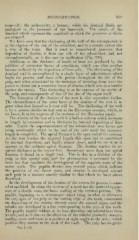Page 583 - My FlipBook
P. 583
DENTiyiFICA TION. 593
bone-cell ; the pulp-eavity, a lacuna ; while the dentinal fibrils are
analogous to the processes of the bone-cells. The canals of the
dentinal tubuli represent the canaliculi in which the processes or fibrils
are situated.
We have seen that the thickening of the wall of the calcospherule is
at the expense of the size of the osteoblast, and to a certain extent this
is true of the tooth. But it must be remembered, however, that
deposition of dentine is from one side of the odontoblast, and not
circumferentially, as is the case in ossification (Fig. 330).
Additions to the thickness of bands of bone are produced by the
addition of successive layers of osteoblasts, which one after another
become enclosed by the deposition of lime salts. The thickening of the
dentinal wall is accomplished by a single layer of odontoblasts which
begin the process, and these cells persist throughout the life of the
pulp, and when stimulated by the irritation of invading decay have the
power to throw out a secondary layer of dentine, which acts as a barrier
against the enemy. This thickening is at the expense of the cavity of
the pulp, and consequently of that of the size of the organ itself
The formation of the dentine of the root is also somewhat similar.
The circumference of the outer layer of the dentine of the root is as
great when first formed as it ever will be. The thickening of the Avail
is by a process similar to that seen in the Haversian systems, which, as
we know, is at the expense of the contents of the Haversian canals.
The dentine of the root of a tooth is a hollow column which increases
in length by extension and in thickness by internal deposition of lime
salts. Under the superintendency of the odontoblasts new layers are
being continually added to the end of the tube until the necessary
length is completed. The apical foramen is the open end of the cohmin.
As the root reaches the required length this open end is constricted
by internal deposition, and finally almost closes, until we see it as it
appears in the ordinary apical foramen. The dentine reaches its re-
quired thickness in the crown first. Sometimes more than one apical
foramen is found in a single root. This is due to a division of the
pulp in this special case, and the phenomenon is governed by the
same law that regulates the development of the separate roots of the
molar teeth. The papilla divides into several parts, which indicate
the position of the future roots, and dentine is developed around
each part in a manner exactly similar to that which we have above
described.
In the development of the dentine of the crown the process is some-
what modified. In shape the dentine of a tooth has the outward appear-
ance of a double cone, the bases uniting at the cervical ])ortion. The
papilla, beginning as a microscopic object lying in Avhat is afterward
the very apex of the pulp at the cutting edge of the tooth, commences
the deposition of the dentine directly under the enamel organ, and the
tubules are developed in a line corresponding to the axis of the tooth.
The papilla rapidly widens at its base, throwing out odontoblasts from
its side, and as it does so the direction of the tubules gradually changes,
tending more and more to a position at right angles to the axis ; which
position they assume at the neck of the tooth. The pulp has its great-
VoL. I.—38


